#European wool carder bee
Text
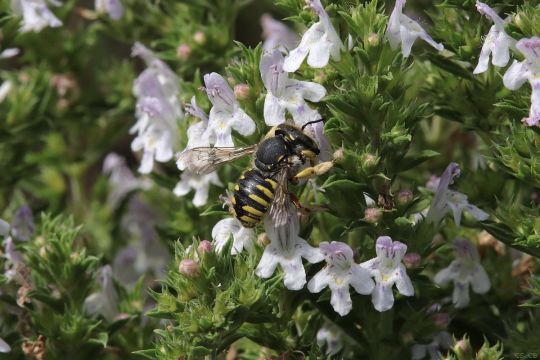
#Wollbiene#Winterbohnenkraut#European wool carder bee#Anthidium manicatum#Winter savory#Wild Life Germany
9 notes
·
View notes
Text
Wool-Carder Bees: these solitary bees harvest the soft, downy hairs that grow on certain plants, rolling them into bundles and then using the material to line their nests

Wool-carder bees build their nests in existing cavities, usually finding a hole/crevice in a tree, a plant stem, a piece of rotting wood, or a man-made structure, and then lining the cavity with woolly plant fibers, which are used to form a series of brood cells.
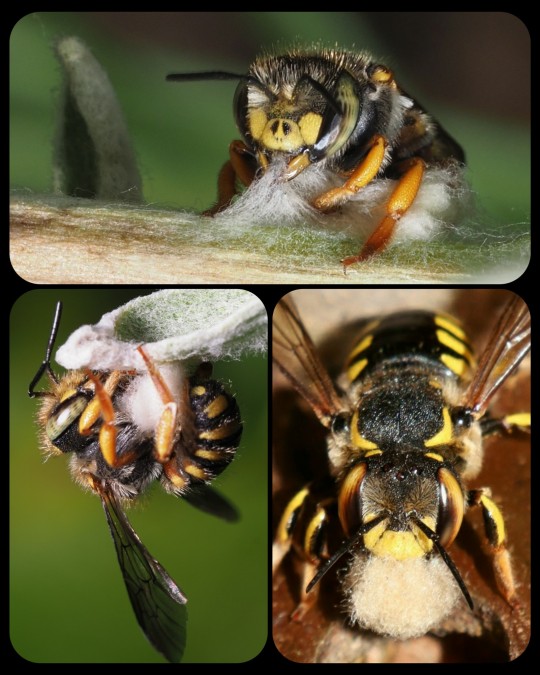
The fibers (known as trichomes) are collected from the leaves and stems of various plants, including lamb’s ear (Stachys byzantina), mulleins, globe thistle, rose campion, and other fuzzy plants.

From the University of Florida's Department of Entomology & Nematology:
The female uses her toothed mandibles to scrape trichomes off fuzzy plants and collects a ball of the material under her abdomen. She transports these soft plant fibers to her selected nest site and uses them to line a brood cell. Next, she collects and deposits a provision of pollen and nectar into the cell, enough pollen to feed a larva until it is ready to pupate. Lastly, she lays a single egg on top of the pollen and nectar supply before sealing the cell. ... She will repeat this process with adjoining cells until the cavity is full.
These are solitary bees, meaning that they do not form colonies or live together in hives. Each female builds her own nest, and the males do not have nests at all.
Female wool-carder bees will sometimes sting if their nest is threatened, but they are generally docile. The males are notoriously aggressive, however; they will often chase, head-butt, and/or wrestle any other insect that invades their territory, and they may defend their territory from intruders up to 70 times per hour. The males do not have stingers, but there are five tiny spikes located on the last segment of their abdomen, and they often use those spikes when fighting. They also have strong, sharp mandibles that can crush other bees.
There are many different types of wool-carder bee, but the most prolific is the European wool-carder (Anthidium manicatum), which is native to Europe, Asia, and North Africa, but has also become established as an invasive species throughout much of North America, most of South America, and New Zealand. It is the most widely distributed unmanaged bee in the world.
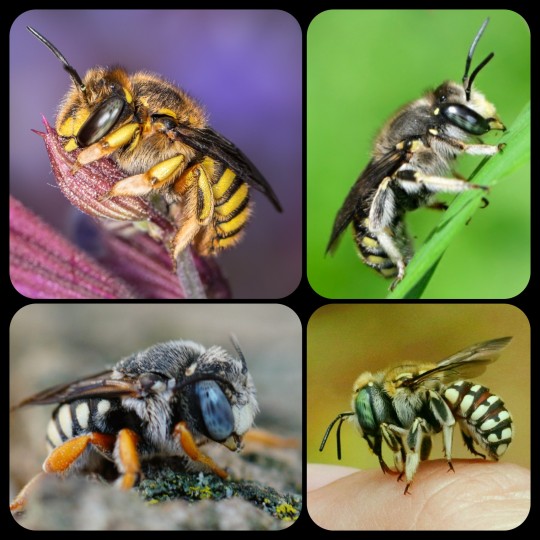
A few different species of wool-carder bee: the top row depicts the European wool-carder, A. manicatum (left) and the spotted wool-carder, Anthidium maculosum (right), while the bottom row depicts the reticulated small-woolcarder, Pseudoanthidium reticulatum, and Porter's wool-carder, Anthidium porterae
Sources & More Info:
University of Florida: The Woolcarder Bee
Oregon State University: European Woolcarder Bees
Bohart Museum of Entomology: Facts about the Wool Carder Bee (PDF)
Bumblebee Conservation Trust: A. manicatum
World's Best Gardening Blog: European Wool Carder Bees - Likeable Bullies
Biological Invasions: Global Invasion by Anthidium manicatum
#entomology#hymenoptera#apiology#melittology#bees#woolcarder bees#nature#insects#arthropods#science#solitary bees#european woolcarder#anthidium#animal facts#cool bugs#cute animals
784 notes
·
View notes
Text

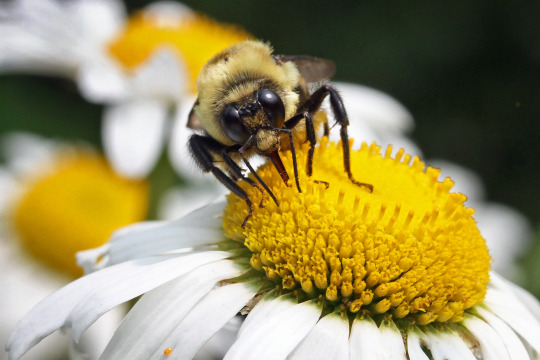
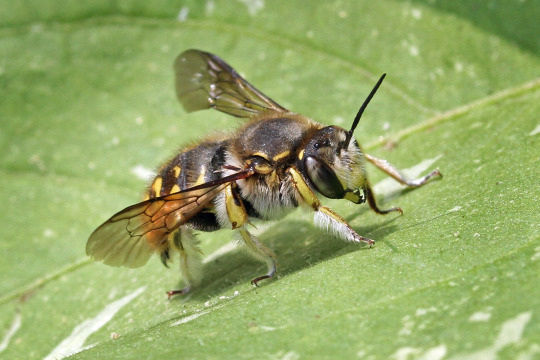
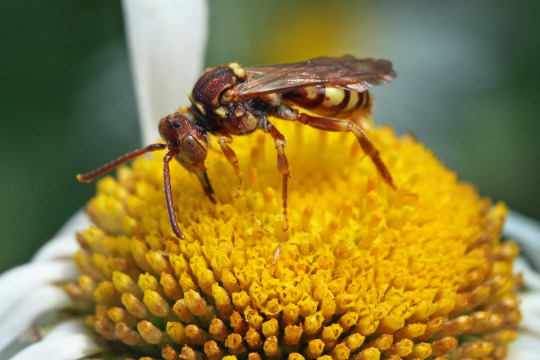
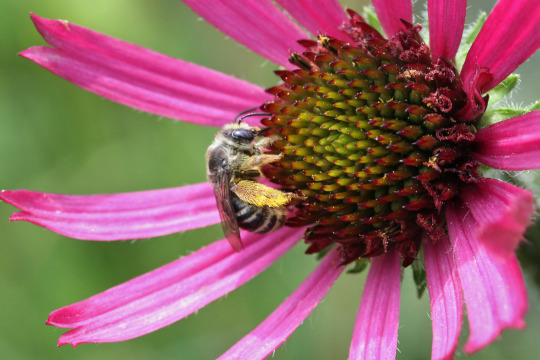
Went to a well-known public garden and found lots of wildlife on the flowers.
Bicolored Striped Sweat Bee (Agapostemon virescens)
Brown-Belted Bumblebee (Bombus griseocollis)
European Wool Carder Bee (Anthidium manicatum)
Nomad Bee (Nomada sp.)
Longhorn Bee (Melissodes sp.)
June 15, 2023
Southeastern Pennsylvania
201 notes
·
View notes
Text


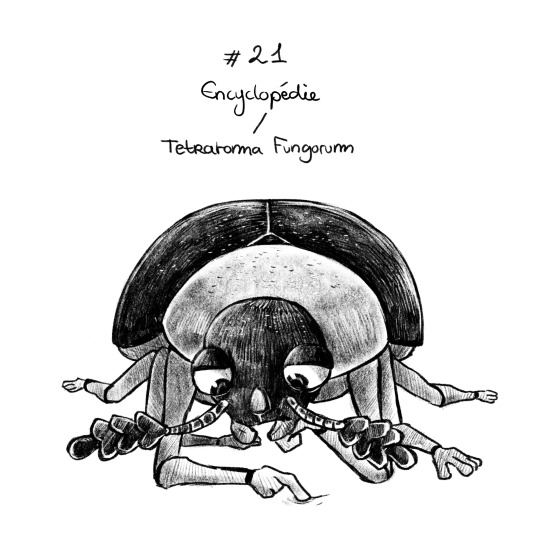

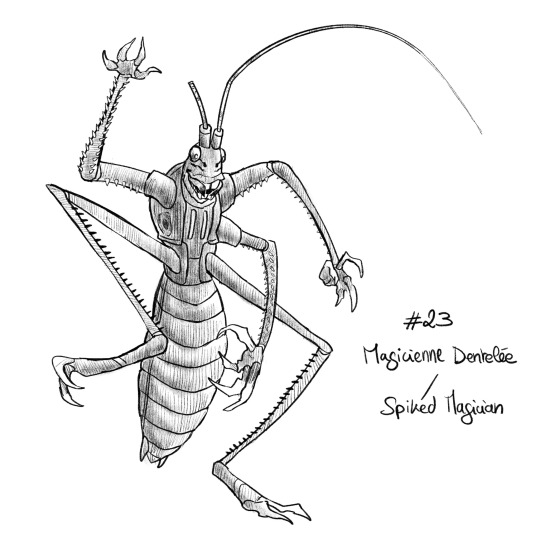
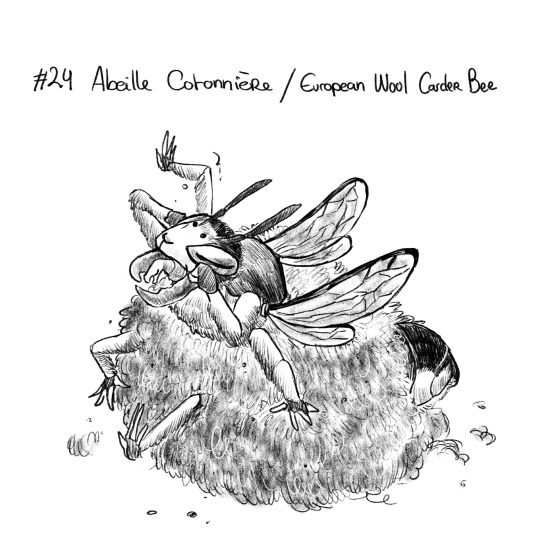
Day 19: Lappet
Day 20: Pygmy Damselfly
Day 21: Tetratoma Fungorum
Day 22: Booklice
Day 23: Spiked Magician
Day 24: European Wool Carder Bee
Part 1 - Part 2 - Part 3 - Part 4 - Part 5
44 notes
·
View notes
Note
Buzz buzz Trick or Treat!
trick or treat trick or treat! Anthidium manicatum, or the european wool carder bee, is one of my favorite kinds of bee! I love how they clip hairs off of plants (think fuzzy ones like lamb’s ear), roll them up, and use them to line their nests!!
here's a video of one doing her thing!
youtube
3 notes
·
View notes
Text
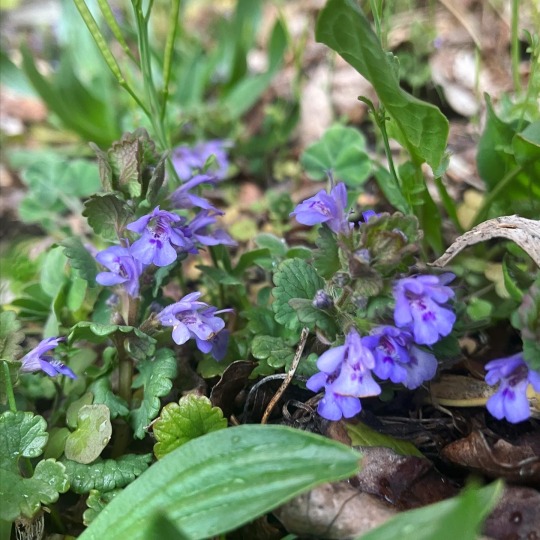
Glechoma hederacea
🌿Glechoma hederacea
Family: Lamiacea (Mint)
Common Names: Ground Ivy, Creeping Charlie, & gill-over-the-ground
Perennial herbaceous plant
Native to Europe, and introduced to North America as early as the 1800's. It is considered Invasive in the U.S as it forms dense patches that can push out native plants.
Pollinators include: Anthophora furcata (Fork-tailed flower bee) Anthidum manicatum (European wool carder bee)
Anthophora plumipes (Hairy-footed flower bee)
Anthophora quadrimaculata (Four-branded flower bee)
Anthophora abrupta (Minor bee)
Osmia aurulenta (Gold-fringed mason bee)
Osmia caerulescens (Blue mason bee)
Osmia lignaria (Blue orchard bee)
#botany#horticulture#botanical#flowers#purple flowers#wildflowers#springtime#invasive species#invasive plants#gardening#plants#the more you know#the more you learn#science rules#creeping charlie#kill your lawn#let them pollinate#flowers for the bees#save the bees#let the bees feed#perennial grasses
8 notes
·
View notes
Note
what are Tawnytrot's kits names + genders?
WoolcarderKit (Molly, after the European wool carder bee)
AshyKit (Molly, after the ashy mining bee)
Everyone in tawny’s bio family line is named after bees (tawny mining bee for tawnytrot, hornets for, well, HornetLeg)!
4 notes
·
View notes
Text
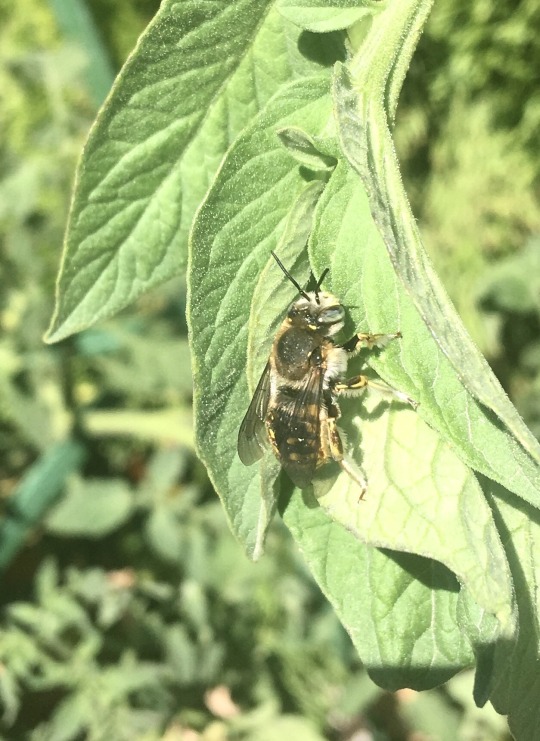
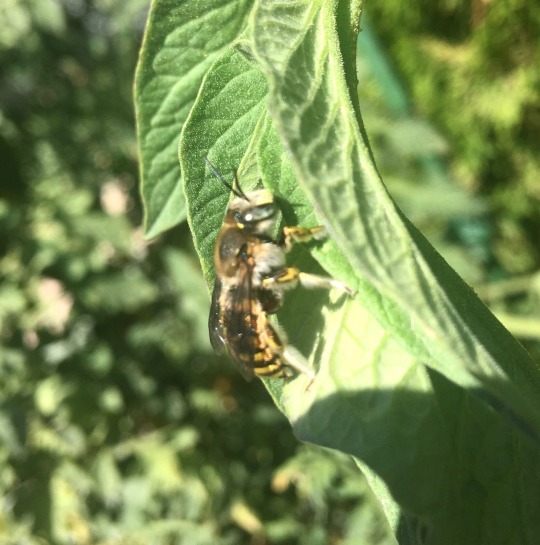
Who’s this guy? He flew just like a hoverfly, but was both substantially larger and more bee-looking than other hoverflies I’ve seen. Would have thought he was a regular bee if not for the way he was flying. He was about the size of a standard honeybee, maybe a litle broader. Found in Salt Lake County, Utah!
Oooh a stylish lil bud! Excellent outfit and eyeballs. Looks to me like a European wool carder bee as far as I can tell from these photos. They’re a type of leaf-cutter bee, but instead of cutting pieces out of the leaves, they scrape off the hairs on the leaves of certain plants to line their nests! They are, unfortunately, invasive in the US.
63 notes
·
View notes
Photo

Suspendue (Abeille Cotonnière♂️)
by Steve Fanouillet
17 notes
·
View notes
Photo

i love dnd
#new character alert#will i ever be able to play them?#probably not#the curse of the forever dm must fall upon someone#but alas#their name is Carder. short for European Wool Carder Bee.#gfhjd#its not that funky of a build; just a firbolg swarmkeeper ranger#im slowly making my way through every ranger subclass for characters i end up falling in love with and then being sad ill never get to play#i mean its POSSIBLE my brother will start a CoS campaign!!! but like carder does not belong in barovia.... fghsjdk#dnd#dnd character#dnd memes#dungeons and dragons
19 notes
·
View notes
Photo
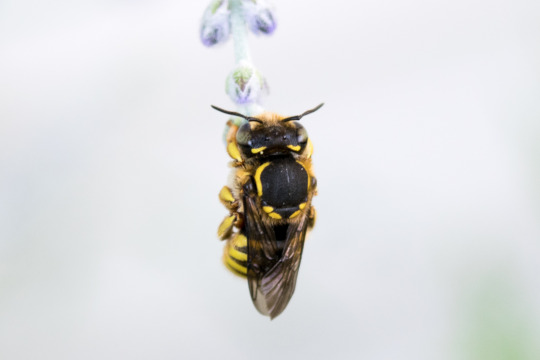
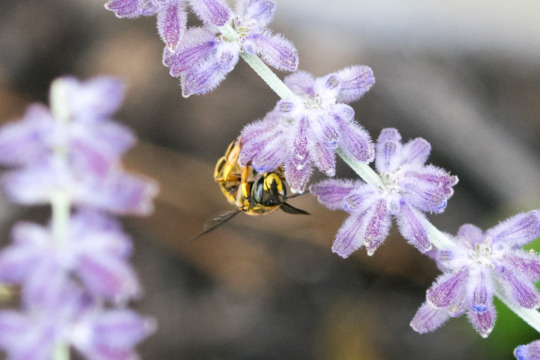
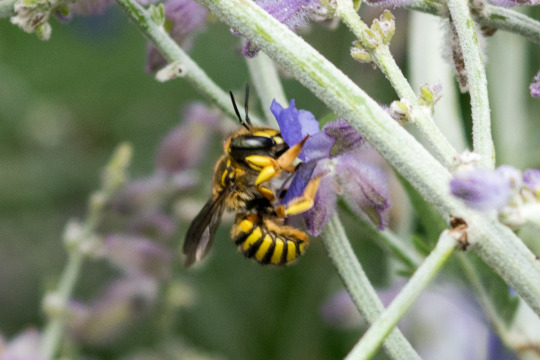

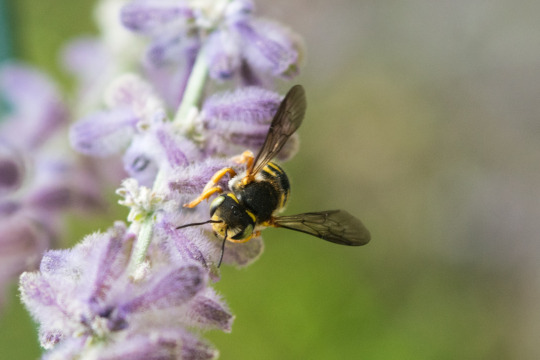




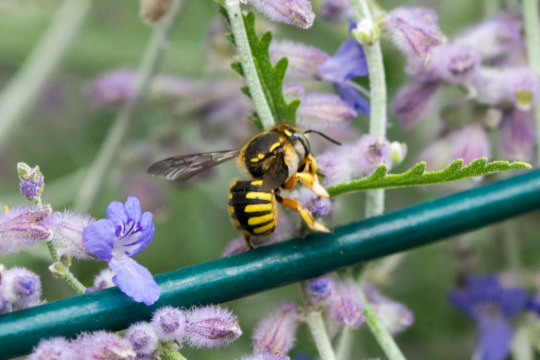
[8/11/20] European Wool Carder Bee, Anthidium manicatum.
These guys steal fuzz off of plants and use it as nest lining.
#bee#bees#european wool carder#insect#insects#outdesign posts things#outdesign attempts to photo#insect catalog#they are very cute even if they are invasive
186 notes
·
View notes
Photo

Ridiculously cute, and only the second one I’ve ever seen.
European wool carder bee (Anthidium manicatum?)
July 29, 2017
Southeastern Pennsylvania
Introduced into the US around 1963 in New York State (If it is A. manicatum.)
#Anthidium manicatum#bee#bees#photographers on tumblr#wool carder bee#european wool carder bee#beeblr
372 notes
·
View notes
Text

European Wool Carder bee, Anthidium manicatum!
These are called “wool carders” because they scrape fuzz off of plants to line their homes with!
21 notes
·
View notes
Photo
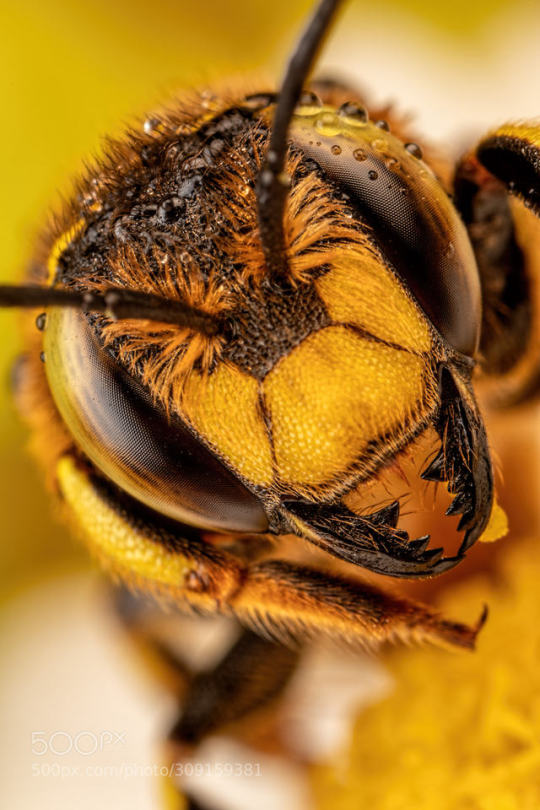
European Wool Carder Bee by dalantech Source: http://bit.ly/2XQhzoT
#macro#macrophotography#insect#insects#bee#wool carder bee#pollen#pollenator#nature photograph#nature
4 notes
·
View notes
Photo

European Wool Carder Bee by dalantech
2 notes
·
View notes
